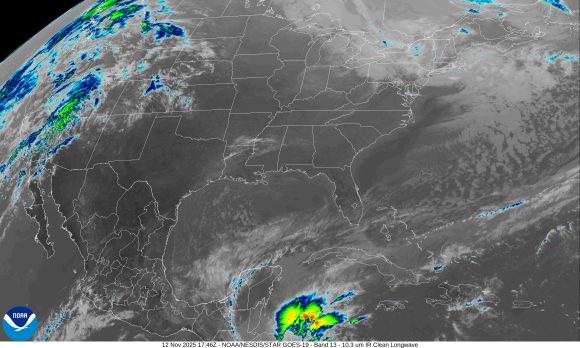The second cold front has finally brought us the first breath of winter, although the air mass is not as cold as many would wish; coats have already had to be worn for the first time (although some people need much less excuse to do so), due to the effect of the lower temperature values and the somewhat strong winds.
With November we enter the final stretch of the hurricane season, and although it always brings a feeling of relief due to the approaching end date of the «hurricane calendar,» and without wishing to be bearers of ill omen, it is no bad thing to remember that November does not always behave quietly. The current month is almost through its first half and no cyclone formation is forecast for the next 7 days, meaning we would reach two-thirds of the month «without a cyclone.» Remember that cyclones do not always follow the calendar. Let us hope that by the usual season tally at the end of the month, the list will have ended at «M».
A «handover» of focus occurs this month; little by little, the questions and doubts about what remains of the hurricane season are turning to how cold the winter will be. All this happens amidst comments that «winters hardly last» nor are they «felt» anymore, almost always evoking (for those who experienced them) those seasons of the 1970s and 1980s.
The Climate Centre of the Institute of Meteorology, in its monthly forecast for the current month, which opens the less rainy period in Cuba, indicated the probability that it will be somewhat rainier than usual, with temperatures close to the average values. This may be related to the arrival of the first winter systems, although they are still followed by not very cold air masses.
The remainder of our winter falls within the less rainy period, the latter spanning from November to April, during which only a quarter of the annual rainfall total is recorded. It is a span in which precipitation and temperatures depend on the passage of cold fronts and migratory anticyclones.
The Rest of the Winter
In the outlook issued by the said centre for both trimesters of the less rainy period: November-January and February-April, it indicates that rainfall behaviour will be within the norm for both periods, although in the second they will tend to be, while within the normal range, closer to the lower limit of it.
The values of extreme temperatures (minimum and maximum) are predicted to behave differently in both trimesters. In the first, with normal behaviour, although in the case of maximum temperatures, at the upper limit of that range, meaning somewhat higher though still within the usual values.
In the second trimester, both temperatures will be somewhat higher than their average values, with minimums at the upper limit of the normal range and, in the case of maximums, they will be above it. This indicates that although we can still have cold days, in general towards the end of winter these will be scarcer, especially during the daytime period.
The Climate Centre clarifies that «It is appropriate to indicate that these predictions characterise the seasonal period as a whole, which does not mean that each month within the period has to present the same behaviour as that expected for the entire trimester.» Therefore, if they are fulfilled to the letter, it could be the result of some months with high behaviour and others with low behaviour in any of the variables.
So, while we in part of Cuba enjoy a breath of winter, we hope that one season will quietly reach its end while the other makes itself felt a little more. (Author: Elier Pila Fariñas)




